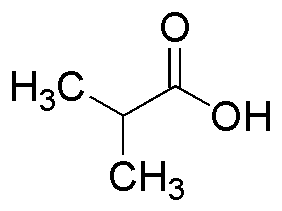Isobutyric acid is widely utilized in research focused on:
- Flavoring and Fragrance Industry: Used as a flavoring agent in food products and as a fragrance component in perfumes, enhancing sensory experiences.
- Pharmaceuticals: Serves as an intermediate in the synthesis of various pharmaceutical compounds, contributing to the development of medications.
- Polymer Production: Acts as a building block in the production of polymers and resins, improving material properties for industrial applications.
- Agricultural Chemicals: Utilized in the formulation of herbicides and pesticides, helping to enhance crop protection and yield.
- Biochemical Research: Employed in studies related to metabolic pathways and cellular processes, aiding researchers in understanding biological functions.
General Information
Properties
Safety and Regulations
Applications
Isobutyric acid is widely utilized in research focused on:
- Flavoring and Fragrance Industry: Used as a flavoring agent in food products and as a fragrance component in perfumes, enhancing sensory experiences.
- Pharmaceuticals: Serves as an intermediate in the synthesis of various pharmaceutical compounds, contributing to the development of medications.
- Polymer Production: Acts as a building block in the production of polymers and resins, improving material properties for industrial applications.
- Agricultural Chemicals: Utilized in the formulation of herbicides and pesticides, helping to enhance crop protection and yield.
- Biochemical Research: Employed in studies related to metabolic pathways and cellular processes, aiding researchers in understanding biological functions.
Documents
Safety Data Sheets (SDS)
The SDS provides comprehensive safety information on handling, storage, and disposal of the product.
Product Specification (PS)
The PS provides a comprehensive breakdown of the product’s properties, including chemical composition, physical state, purity, and storage requirements. It also details acceptable quality ranges and the product's intended applications.
Certificates of Analysis (COA)
Search for Certificates of Analysis (COA) by entering the products Lot Number. Lot and Batch Numbers can be found on a product’s label following the words ‘Lot’ or ‘Batch’.
*Catalog Number
*Lot Number
Certificates Of Origin (COO)
This COO confirms the country where the product was manufactured, and also details the materials and components used in it and whether it is derived from natural, synthetic, or other specific sources. This certificate may be required for customs, trade, and regulatory compliance.
*Catalog Number
*Lot Number
Safety Data Sheets (SDS)
The SDS provides comprehensive safety information on handling, storage, and disposal of the product.
DownloadProduct Specification (PS)
The PS provides a comprehensive breakdown of the product’s properties, including chemical composition, physical state, purity, and storage requirements. It also details acceptable quality ranges and the product's intended applications.
DownloadCertificates of Analysis (COA)
Search for Certificates of Analysis (COA) by entering the products Lot Number. Lot and Batch Numbers can be found on a product’s label following the words ‘Lot’ or ‘Batch’.
*Catalog Number
*Lot Number
Certificates Of Origin (COO)
This COO confirms the country where the product was manufactured, and also details the materials and components used in it and whether it is derived from natural, synthetic, or other specific sources. This certificate may be required for customs, trade, and regulatory compliance.


